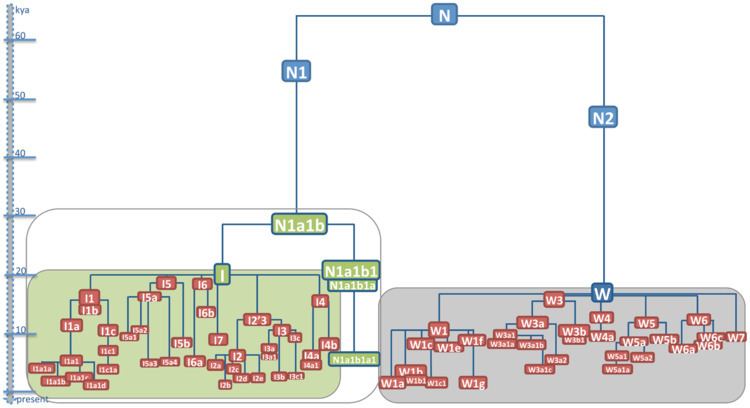Ancestor N1e'I | Descendants I1, I2'3, I4, I5, I6 | |
 | ||
Possible time of origin 20,857 ± 3,594 Years Before Present (Behar 2012b) Possible place of origin West Asia (Terreros 2011 and Fernandes 2012) Defining mutations T10034C, G16129A!, G16391A (Behar & Family Tree DNA 2012) | ||
Haplogroup I is a human mitochondrial DNA (mtDNA) haplogroup. It is largely distributed in Europe and West Asia, and is also found among some Afroasiatic-speaking populations in Africa. The clade is believed to have evolved in West Asia (see Origin and Distribution).
Contents
Origin
Haplogroup I is a descendant (subclade) of haplogroup N1e'I (Behar 2012b) and sibling of haplogroup N1e (Behar 2012b). It is believed to have arisen somewhere in West Asia between 17,263 and 24,451 years before present (Behar 2012b). It has been suggested that its origin may be in Iran or more generally the Near East (Terreros 2011).
A similar view puts more emphasis on the Persian Gulf region of the Near East (Fernandes 2012).
Distribution
Haplogroup I is found at moderate to low frequencies in East Africa, Europe, West Asia and South Asia (Fernandes 2012). The rare basal/paraphyletic clade I* has been observed in three individuals; two from Somalia and one from Iran (Olivieri 2013).
Africa
Outside of Europe, the highest frequencies of mitochondrial haplogroup I observed so far appear in the Cushitic-speaking El Molo (23%) and Rendille (>17%) in northern Kenya (Castrì 2008). The clade is also found at comparable frequencies among the Socotri (~22%).
Asia
Haplogroup I is present across West Asia and Central Asia, and is also found at trace frequencies in South Asia. Its highest frequency area is perhaps in northern Iran (9.7%). Terreros 2011 notes that it also has high diversity there and reiterates past studies that have suggested that this may be its place of origin. Found in Svan population from Georgia(Caucasus) I* 4.2%."Sequence polymorphisms of the mtDNA control region in a human isolate: the Georgians from Swanetia."Alfonso-Sánchez MA1, Martínez-Bouzas C, Castro A, Peña JA, Fernández-Fernández I, Herrera RJ, de Pancorbo MM. The table below shows some of the populations where it has been detected.
Western Europe
In Western Europe, haplogroup I is most common in Northwestern Europe (Norway, the Isle of Skye, and the British Isles). The frequency in these areas is between 2 and 5 percent. Its highest frequency in Brittany, France where it is over 9 percent of the population in Finistere. It is uncommon and sometimes absent in other parts of Western Europe (Iberia, South-West France, and parts of Italy).
Eastern Europe
In Eastern Europe, the frequency of haplogroup I is generally lower than in Western Europe (1 to 3 percent), but its frequency is more consistent between populations with fewer places of extreme highs or lows. There are two notable exceptions. Nikitin 2009 found that Lemkos (a sub- or co-ethnic group of Rusyns) in the Carpathian mountains have the "highest frequency of haplogroup I (11.3%) in Europe, identical to that of the population of Krk Island (Croatia) in the Adriatic Sea".
Historic and Pre-Historic Samples
Haplogroup I has so far been absent from ancient European samples found in Paleolithic and Mesolithic grave sites. One early example has been found in Neolithic Spain (c. 5000 cal BC in Paternanbidea), but its subclade was not determined. Haplogroup I displays a strong connection with the Indo-European migrations; especially its I1, I1a1 and I3a subclades, which have been found in Poltavka and Srubnaya cultures in Russia (Mathieson 2015), among ancient Scythians (Der Sarkissian 2011), and in Corded Ware and Unetice Culture burials in Saxony (Brandt 2013). Haplogroup I (with undetermined subclades) has also been noted at significant frequencies in more recent historic grave sites (Melchior 2008 and Hofreiter 2010).
In 2013, Nature announced the publication of the first genetic study utilizing next-generation sequencing to ascertain the ancestral lineage of an Ancient Egyptian individual. The research was led by Carsten Pusch of the University of Tübingen in Germany and Rabab Khairat, who released their findings in the Journal of Applied Genetics. DNA was extracted from the heads of five Egyptian mummies that were housed at the institution. All the specimens were dated to between 806 BC and 124 AD, a timeframe corresponding with the Late Dynastic and Ptolemaic periods. The researchers observed that one of the mummified individuals likely belonged to the I2 subclade.
Haplogroup I5 has also been observed among specimens at the mainland cemetery in Kulubnarti, Sudan, which date from the Early Christian period (AD 550-800).
Samples with unknown subclades
The frequency of haplogroup I may have undergone a reduction in Europe following the Middle Ages. An overall frequency of 13% was found in ancient Danish samples from the Iron Age to the Medieval Age (including Vikings) from Denmark and Scandinavia compared to only 2.5% in modern samples. As haplogroup I is not observed in any ancient Italian, Spanish [contradicted by the above, "early examples have been found in Neolithic Spain (c. 5000 cal BC in Paternanbidea)"], British, central European populations, early central European farmers and Neolithic samples, according to the authors "Haplogroup I could therefore have been an ancient Southern Scandinavian type “diluted” by later immigration events" (Hofreiter 2010).
Tree
This phylogenetic tree of haplogroup I subclades with time estimates is based on the paper (van Oven 2008) and subsequent published research (Behar 2012b).
I2'3
Examples of this ancestral branch have not been documented.
I2a1
Current available data indicates that this may be a Northwestern European branch.
